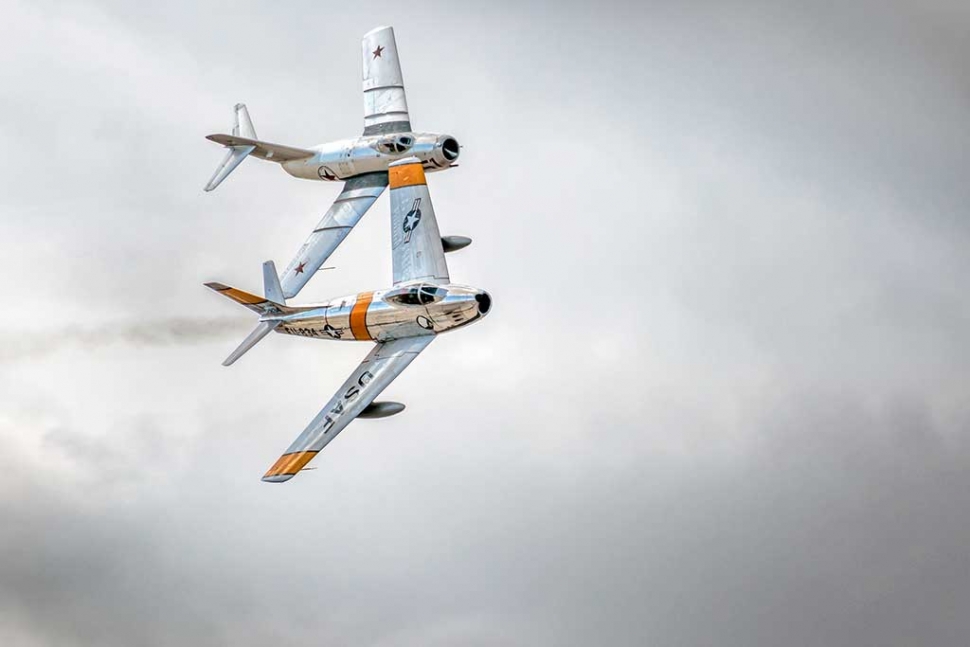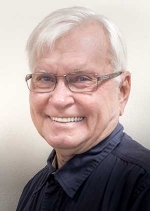|
Photography Know-How
 Photo of the Week "F-86F Sabre & Mikoyan-Gurevich Fagot Mig-15" By Bob Crum. Photo data: Canon 7D MKII, Manual mode, ISO 100, Tamron 18-400mm lens @355mm, aperture f/9.0, shutter speed 1/800th of a second. By Bob Crum — Wednesday, April 11th, 2018
Rule of Thirds
 Bob Crum Air shows present so many photographic challenges that lots of attempted shots are missed. Proof of this is exhibited by the profusion of expletives uttered by other photogs in the media area. On the other hand, 'money' shots captured are accompanied with a loud, joyful BOOYA! My goal: More booyas than dagnabbits! For safety reasons air show planes fly at a designated distance away from the audience. Without a super-telephoto lens, aircraft performing off in a distance look like ants on the screen of an outdoor theater. Tiny! I don't own a super-telephoto lens because my normal assignments don't require one. Therefore, for special occasions like air shows, I rent one. For past air shows I rented a Canon EF 100-400mm f/4.5-5.6'L' lens. Superb optics but weighs a hefty 3.5 pounds. With that lens on my 2 pound Canon 7D2 I'm lifting a hefty 5 pounds. Think about holding up five pounds for 3-1/2 hours! Add two pounds each hour because as we grow older gravity gets stronger... so it seems. This year I threw caution to the stratosphere and risked renting the Tamron 18-400mm telephoto lens instead of the Canon lens. Can a lens that costs 2/3 less than the premium Canon 'L' lens perform as advertised... and hoped? I was delightfully surprised. I can't say the image quality is precisely as good as the Canon lens, but it was up to the task. It takes a discerning eye to see significant difference in image quality. My arms so loved the lighter load they're hoping I'll consider buying that lens. Silly arms! The photo of the week is a Sabre and Mig approaching together but far out. Therefore I zoomed all the way to 355mm. Why not all the way to 400mm you ask? Framing fast flying jets in the viewfinder is tricky so best leave room for error while also attempting to adhere to the photographic 'rule of thirds'. While the 'rule of thirds' is preferred it's not easy to accomplish with fast moving jet aircraft. To understand and apply the photographic rule of thirds, imagine breaking up an image into thirds both horizontally and vertically. The four intersection points of these lines are where subjects should be placed to create a strong, balanced image. Like all rules, break as needed! Studies have shown that when viewing images people’s eyes tend to go to one of the intersection points most naturally rather than the center of the image. When viewing the photo of the week, do your eyes naturally go to the upper left third of the photo? Works, doesn't it? Or did your eyes naturally go to the left third of the photo because that's where the planes are? It's good to try to apply the rule of thirds when possible but not always applicable. Also, perfect focus on fast subjects is hit and miss... mostly miss. For example, as a jet is approaching, I'll start panning with it as soon as I see it in the viewfinder. Using back-button focus on my camera, I'll mash the focus button as soon as I see the plane in the frame. Timing is key. Wait for it... wait.... wait.... BOOYA! Since it all sounds like a chore, why do it? Because the thrill of capturing booya photos trounce the trials and tribulations. More importantly, I delight in story telling by photos (photojournalism). Lastly, I finally finished the photo/video of the Blue & Gray Civil War reenactment. View it here... https://youtu.be/nqSLR5eJOvc . Send your comments, questions, or suggestions to bob@fillmoregazette.com |
